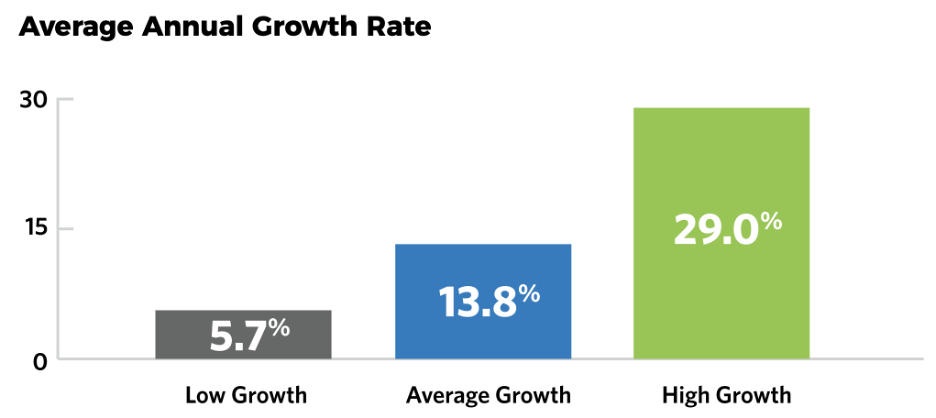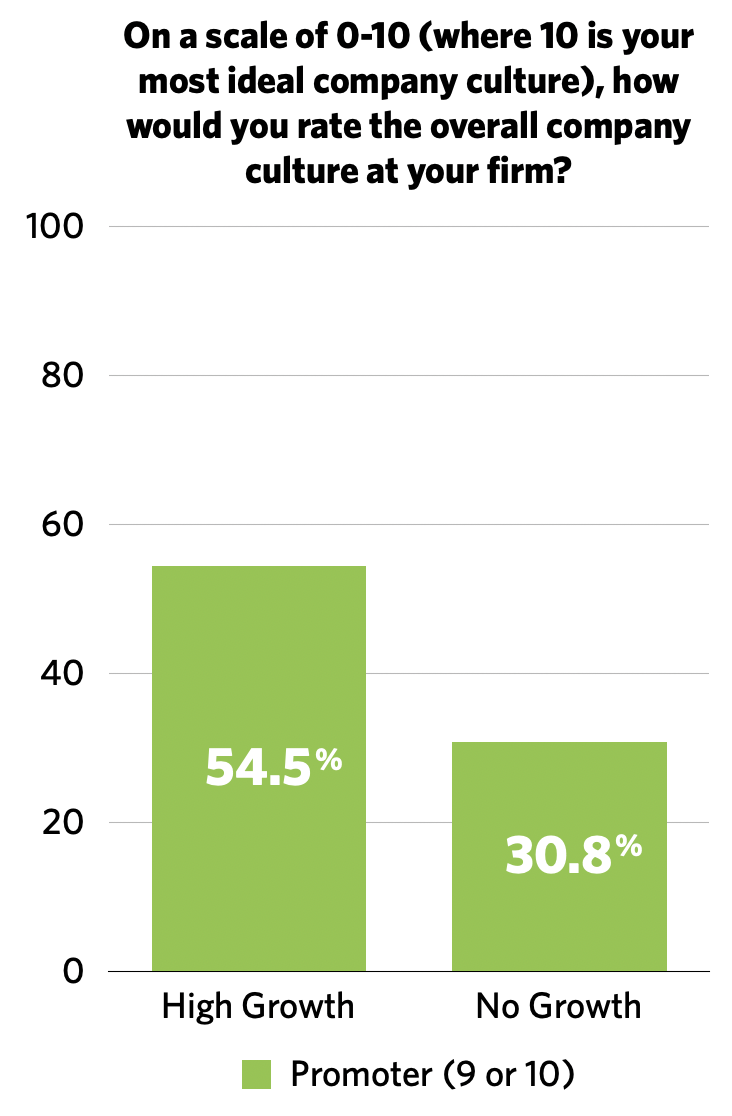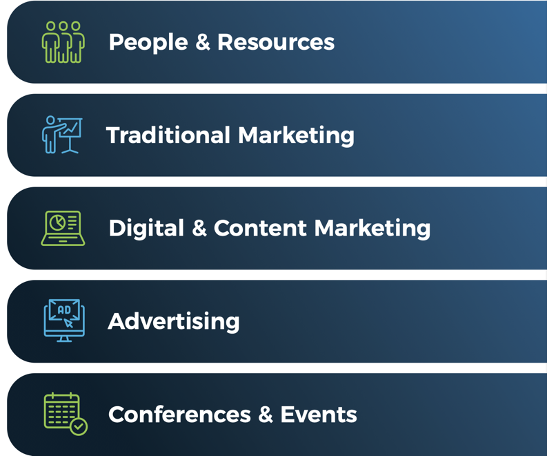How do today’s accounting firms build and utilize their marketing budgets? And what can we specifically learn from those firms growing the fastest?
For over a decade, the Association for Accounting Marketing (AAM) has partnered with Hinge to research, analyze and provide the valuable insights accounting marketers and executive leadership teams need to develop high-performing marketing programs. The 2023-24 Marketing Budget Benchmarking Study is the latest edition of this research partnership that is dedicated to uncovering the details of high-performance accounting marketing teams.
The focus areas of this year’s study include: How firms organize their marketing and business development teams, how marketing teams support talent recruiting and retention initiatives, and what kinds of technology accounting firms use to propel their marketing programs. This year, we’ve also expanded the list of marketing techniques we evaluate to include many of the latest methods.
What has not changed is perhaps the most valuable portion of the study—analysis of what the fastest growing firms do differently than their slower growing peers. As you continue to develop your firm’s marketing program, you can model your strategy, tools, and techniques on those used by the most successful firms in your industry.
In this blog post we’ll cover some of the key highlights of this year’s study and what it might mean for your marketing efforts. If you want to dig deeper, and we encourage you to do so, please check out the free Executive Summary, available here, and purchase the full report which is available at the AAM website.
About the Research Study
The average firm in this year’s study had 489 employees and about $95 million in revenue. These are substantial firms. The entire sample represents more than $6 billion in revenue with 49,000 full-time professionals and 2,400 marketing and business development (BD) employees.
The sample was segmented into High Growth firms (fastest growing 25%) and Low Growth firms (slowest growing 25%). The 50% in the middle were designated as Average Growth firms. Figure 1 shows the growth rates for each group. The High Growth firms are growing over 5 times faster than their Low Growth peers.

Industry Trends
The accounting profession has been rocked by a series of profound changes. First among these has been the elevated level of uncertainty. Unpredictability has rocked many industries, including accounting. Add to that a growing talent shortage and you have many firms faced with the prospect of not being able to service their market’s growing needs.
This has caused many firms to rethink their business models and the services they offer. Data from the study shows that many firms have diversified well beyond traditional core services such as tax and assurance.
One may wonder how to grow an accounting firm in an environment with so much turbulence and uncertainty. Fortunately, the High Growth firms in this study provide something of a roadmap for how to thrive in this challenging marketplace.
Let’s touch on three of the key areas where High Growth firms have a distinct advantage over their slower growing competitors.
Talent
By several measures High Growth firms invest more in their marketing and BD talent. First, they staff at higher levels. Marketing and BD professionals support a fewer number of total employees in High Growth firms. They also make greater use of outside talent, such as consultants or marketing agencies, than do their slower growing peers.
Importantly this is not an advantage they are about to give up. In fact, 100% of High Growth Firms plan to increase spending on talent. But it is not just a matter of spending more on talent.
Employees at High Growth firms are more satisfied with their firm’s culture than are employees at slower growing firms. This figure shows the proportion of employees that are very satisfied (ratings
of 9 or 10 on a 10 point scale) with the culture of their firm. While well over half of employees (54.5%) at High Growth firms are very satisfied, while only about 3 of 10 employees (30.8%) in Low Growth firms feel the same way.

The full report explores what specific culture building techniques the High Growth firms are using to help build and reinforce that culture. We also explore their role in helping to communicate that culture to support recruiting.
Technology
Technology is playing an increasing role in High Growth firms. One of the key findings is that High Growth firms have a much greater level of digital maturity than do their Low Growth peers.
One of the ways that this greater level of maturity is expressed is in the greater usage of software to support the marketing and BD functions. Take a look below to see three examples of software types where High Growth firms are much heavier users.

Put another way, not only do High Growth Firms invest in talent, but they also give them more sophisticated tools to work with. This is a real impact multiplier.
Marketing Techniques
Today’s changing marketplace is requiring today’s accounting marketers to rethink where they allocate their marketing dollars. To better understand what’s happening, we organized the list of
marketing techniques into the five core categories shown below.

In the full report, you’ll gain access to a detailed breakdown of each category. You will learn what marketing techniques are used most often, how firms allocate their budgets, and where the High Growth firms plan to increase spending. Let’s review a couple of highlights.
We mentioned that High Growth firms tend to invest more in people. They are also spending somewhat less on traditional marketing. But as interesting as these overall allocations are, the real insights lie in looking at the specific techniques favored by High Growth firms.
For example, public relations, both traditional and digital varieties, are favored by High Growth firms. But when they do invest in PR, it tends to be less focused on traditional PR and more focused on the digital varieties.
The digital maturity of High Growth firms is also reflected in their marketing practices. Over 9 of 10 (90.1%) High Growth firms already invest in search engine optimization (SEO). And their plan for the future? Increase spending further. Interestingly, digital PR is an important tool for accelerating SEO gains. Clearly, there is a lot to learn from the technique selections that High Growth firms make.
What You Will Learn in the Full Report
The full report is organized into seven major sections.
- Overall Firm Profiles — This section offers an overview of the firms in the sample. It gives their overall financial performance, including top line revenue, revenue per office, revenue per equity partner, revenue per employee, and average annual growth rate. It then details the services offered by all firms. A marketing profile is also included covering the size and composition of the marketing function and their budget and salary averages. Finally, we examine how the marketing teams are organized and their reporting relationships.
- Growth Profiles: High Growth vs. Low Growth — In this section we examine the composition and the profile of firms that are designated as High Growth, Average Growth, and Low Growth. We’ll look at their financial performance compared to each other and also the profiles of their marketing departments and service offerings. Finally, we’ll look at the marketing team organization and reporting relationships.
- Budget Allocation/Control — This section covers how the budget is allocated among the five primary categories. We’ll look at the percentage of spending on each category and then break it down comparing High Growth and Low Growth firms. Next, we’ll investigate the budgeting process and the number of industry practice areas supported in both High and Low Growth firms.
- Marketing Spend & Strategies — This section provides a detailed breakdown of marketing technique usage across all firms and then investigates how it breaks down between High Growth and Low Growth firms. Then we look at the budget allocation across all firms and again compare spending by High and Low Growth firms. Finally, we look at the spending priorities for High Growth Firms going forward. In other words, we’re asking: How do the firms that are currently performing the best plan to adjust their budgets in future budget.
- Spending by Firm Size — We know that spending varies by the size of the firm. There are certain core functions that every firm needs to have. This breakdown is very important when you are benchmarking your marketing budget. We group respondents into four size categories ranging from small firms with less than $5 million in revenue to major firms with more than $50 million in revenue. We then provided a size breakdown of the firm profile and the financial performance including revenue per office, revenue per equity partner, revenue per employee, and annual growth rate. We did a similar breakdown for the marketing profile looking at the ratio of marketing employees to full time equivalent and how budget percentages vary by firm size. Finally, we investigated the services offered by firms of various sizes.
- Importance of Company Culture — Next we dive into the important topic of company culture. We first look at the involvement marketing has in the hiring process. Next, we investigate the methods they use for strengthening company culture and do a breakdown between High Growth and Low Growth firms. Finally, we look at the satisfaction levels across High Growth, Average Growth and Low Growth firms. This section will help you understand the importance of your company culture and how firms are investing in recruiting and retention efforts.
- Digital Maturity — We start this session by looking at the overall levels of digital maturity and then break them down between High Growth and Low Growth firms. We investigate how this translates into the use of specific types of software that support the marketing and business development function. Within each area of software, we then look at the most popular software programs among all firms and then specifically among High Growth firms. This information provides something of a road map for how accounting firms might accelerate adoption of technologies that will contribute to the growth of the firm.
There is also an interactive worksheet included to allow you to benchmark your firm against the most relevant industry standards. This is a great tool to analyze and plan your spending recommendations. And finally, the appendix offers full descriptions of the specific expenses included in each spending category.
A Final Thought
More is being demanded from accounting marketers than ever before—making the planning and budgeting increasingly difficult. From attracting top talent to integrating the latest technologies, today’s marketers are wrestling with problems, old and new, in their quest to help their firms to become more visible and grow.
For over a decade, marketers have turned to this research study from AAM to understand what’s happening across the accounting marketplace and what the best performing firms do differently. With this research at your side, you can reduce your risk, engage more rapidly and bring new clarity and perspective to the marketing planning process.
Get your copy of the free Executive Summary here and purchase the full report from the AAM website.
How Hinge Can Help
Hinge offers a full suite of research-driven branding and marketing services that provide accounting firms with the insights, tools and support needed to achieve extraordinary growth and profitability. Learn more about how we help accounting firms of all sizes take their marketing programs to a new level of performance and reliability here on this page.


